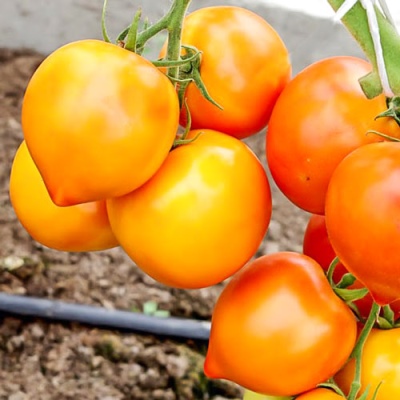
- Authors: Blokin-Mechtalin V.I.
- Year of approval: 2021
- Name synonyms: Golden Mile F1
- Category: hybrid
- Growth type: determinant
- Appointment: fresh consumption, for pickling and canning, for whole-fruit canning, for canning in slices
- Ripening period: early
- Ripening time, days: 95-100
- Growing conditions: for open ground, for film greenhouses
- Transportability: good
One of the novelties on the seed market is an unusually beautiful early maturing determinant hybrid Golden Mile (synonym - Golden Mile F1). The tomato produces delicious and beautiful fruits, used for fresh consumption, preparation of summer and winter salads, in cooking, as well as for whole-fruit canning. The plant is grown outdoors and in all types of greenhouses, up to greenhouses of sufficient height. Good keeping quality and transportability were noted, as well as a large yield of marketable fruits.
Breeding history
The authorship in the development of the hybrid belongs to V.I. Blokin-Mechtalin, in 2021 the hybrid was approved for use.
Description of the variety
Compact, low (up to 100 cm) bushes of medium foliage covered with gray-green foliage of moderate size. Yellow flowers are collected in simple inflorescences, the first of them is laid over 6–7 leaves, all subsequent ones - through 2 cuttings. There are usually 5 to 7 tomatoes in a cluster, which are attached to a strong stalk with articulations.
The main qualities of the fruit
Unripe, rounded, slightly ribbed fruits with a well-defined spout are colored green. It changes to orange-golden at the stage of technical and physiological ripeness of berries. All thick-walled fruits are leveled, weighing 200-220 grams, have 3-4 seed chambers with a small number of seeds.
Taste characteristics
Dense juicy pulp with a pleasant elastic, but not tough, consistency, has a balanced tomato flavor, where a sufficient amount of sugars is balanced by a slight sourness. The thin skin is firm, but hardly noticeable while eating.
Ripening and fruiting
The hybrid belongs to the early ripening category, its ripening period is 95-100 days, which makes it possible to get ripe tomatoes even in cold regions.
Yield
The Golden Mile has rather high yield rates - up to 16.2-16.5 kilograms of wonderful fruits are harvested per square meter.
The timing of planting seedlings and planting in the ground
An early ripe hybrid makes no sense to sow seedlings too early. Based on the generally accepted timing of disembarkation in a permanent place in 55-60 days, sowing can be carried out in late March - early April.

Growing tomato seedlings is an extremely important process, because it largely depends on whether the gardener can harvest at all. All aspects must be taken into account, from seedbed preparation to planting in the ground.
Landing scheme
For optimal harvesting, the plant does not need too much space, it is enough to leave a distance between the roots of 50x50 cm and plant 3-4 plants per 1 sq. meter.

Growing and care
Seedlings of the Golden Mile Hybrid must be hardened before planting in a permanent place. In about 2 weeks, containers with tomatoes begin to be taken out into the street or on an open balcony. Young and tender seedlings should get used to the ambient temperature, its daily fluctuations and too active solar radiation. After transplanting, even hardened seedlings need shading from the sun, unless cool, cloudy weather is established.
A place for planting in the open field is chosen with sufficient lighting. Ideal predecessors are carrots and onions, cucumbers and legumes. In greenhouses, they usually do not take up space for the beds, but many people plant cucumbers to get earlier fruits. Here they can be swapped with a tomato.
In spring, the soil is enriched with organic matter (humus, compost, bird droppings), complex mineral fertilizers, and wood ash. If the garden has heavy, acidified loamy soil, it is necessary to take measures to deoxidize and loosen it. The first problem is solved by introducing bone or dolomite flour, chalk or gypsum. As for the second problem, there are several ways to deal with it. Some of them are designed for a long time, others fulfill their task immediately. For example, planting green manure is an effective method, but a positive result will not be noticeable immediately. Using buckwheat husks in the garden will not only help to quickly improve the structure of the earth, but also enrich its composition with vitamins and microelements, and also attract earthworms, who really like its aroma.
After planting seedlings in a greenhouse or in a vegetable garden, caring for them consists in timely watering, weeding, loosening, hilling. Growing the Golden Mile requires the grower to form a bush of 2-3 stems. The lower leaves are removed after the formation of the first cluster and almost completely break off the foliage after the mass ripening of the crop begins. Top dressing is carried out at least 3 times per season.




A plant needs different micronutrients at each stage of growth. All fertilizers can be divided into two groups: mineral and organic. Folk remedies are often used: iodine, yeast, bird droppings, eggshells.
It is important to observe the rate and period of feeding. This also applies to folk remedies and organic fertilizers.
Disease and pest resistance
The hybrid has excellent resistance to bacterial wilting and other diseases. It resists the tobacco mosaic virus (TMV) well, however, preventive treatments with insecticides and fungicides are required.


Growing regions
The Golden Mile is intended for cultivation in the Northern, North-Western, Central, Volgo-Vyatka, TsChO and North Caucasian districts. Suitable for tomato cultivation Middle Volga, Lower Volga, Ural, West Siberian, East Siberian and Far Eastern regions.

























































































